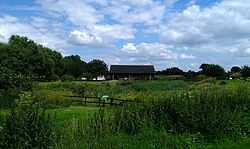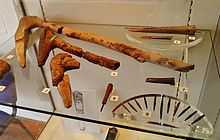Flag Fen
| Flag Fen | |
|---|---|
 The Flag Fen centre and surrounding archaeological site | |
 Location within Cambridgeshire
| |
| Coordinates | 52°34′26″N 0°11′24″W / 52.574°N 0.190°W |
| Type | Archaeological open air museum |
| Website | Flag Fen |
Flag Fen, south-east of Peterborough,[1] England, is a Bronze Age site comprising over 60,000 timbers, arranged in five very long rows,[2] creating a wooden causeway, (around 1 km long), across the wet fenland. Part way across the structure, a small island was formed, where it is presumed religious ceremonies occurred. Archaeological work began at the site, which is located 800m (0.5 miles) east of Fengate,[3] in 1982.[4]
Construction
A Neolithic trackway once ran across, what archaeologists have termed, the "Flag Fen Basin" basin, from a dryland area known as Fengate,[4] to a natural clay island called Northey,[5] (now the site of Whittlesey).[6] The basin is an embayment of low-lying land on the western margins of the Fens,[7] and, the level of inundation by 1300 B.C., led to the construction of a timber causeway along the trackway route.[6]
The causeway, and center platform, were formed by driving 'thousands of posts with long pencil-like tips' through the 'accumulating peaty muds' and into the firmer ground below.[6] The resulting structure covered three and a half acres.[8] Dendrochronological analysis, or dating of the posts by studying tree rings, led to an estimated date for the various stages of construction of between 1365–967 BC.[2]
Some of the timbers, such as oak, were not natural to the local environment.[2] This means that the people who constructed this timber causeway wanted to use materials that perhaps had religious significance to their lives, and felt that it was worth the effort to transport the timbers from far lying sources to the site itself.[2] This isn't rare in the prehistoric world, as the bluestones from Stonehenge were brought to the site in Salisbury from the Preseli Mountains in Wales.
Purpose



Many items denoting 'rank and prestige' were deposited in the surrounding water of Flag Fen,[9] including swords, spearheads, 'gold earings, tiny pins and brooches'.[6] Archaeologist Francis Pryor, who discovered the site, suggests that 'settlers often vied for social status by showing they could afford to discard valuable possessions'.[8] There is also evidence of intentional destruction before placement, e.g., daggers broken in half placed on top of each other.[10]
Other finds included small, polished, white stones of a type not known in the area, indicating that they had been intentionally collected, transported to, and placed at the site.[2] Significance is also drawn from the discovery of the ritual deposits within thirty metres of the timber post line, and only on its southern boundary.[11]
The amount, type and placement of deposits, which continued for over 1,200 years,[12] supports the theory that 'at least one facet of the site' was a role as a 'religious monument'.[9]
Other artefacts that were found comprised animal bones. Of these, horse mandibles were found. Horses were very valuable to the prehistoric people, as they provided not only a means of transport, but also man power. They could be used to carry timbers, for example, over long distances.
On Northey Island, many round barrows, contemporary with Flag Fen, were found. These seemed to be constructed over the dwellings of 'chiefs'. Mike Parker Pearson refers to this as the "Land of the Dead", although there is evidence of farming, including sheep remains, contemporary with the site. Phosphate analysis reveals high concentrations of cremations in the barrows, in the form of satellite and secondary burials in the round barrows. This suggests that the primary burials may have been of chiefs, or socially powerful/respected people, and that some people may have paid to be buried close to the person they respected or followed.
Later history
In the 10th century BC the ground level was much lower than today, increasing around 1 mm (0.039 inches) per year as autumnal debris is added to the surface of the fens. By the early Roman period most of the structure was covered and preserved.[13] The anaerobic conditions found in the waterlogged soil prevented the timbers and other wooden objects from rotting away.
Due to its waterlogged condition, the Flag Fen Basin saw the development of peat deposits around 2000 BCE, which still exist there today.[14]
Archaeological investigation
The site was first discovered in 1982 when a team led by Francis Pryor carried out a survey of dykes in the area funded by English Heritage.[4] Pryor told National Geographic (magazine), in 1992, he 'stumbled - literally - upon' Flag Fen 'when he tripped on a piece of wood lying in the bottom of a drainage ditch.'[8]
Excavation commenced in the summer of 1984 and, by 1990, had revealed vertical and horizontal timbers, animal bones, a bronze dagger and other metal items and fragments, flint implements and 400 potsherds.[4] Further finds included items imported from continental Europe and the oldest surviving wooden wheel found in England.[15]
Preservation
Due to extensive drainage of the surrounding area, many of the timbers are drying out and are threatened with destruction.[6] One section of the poles is being preserved by replacing the cellulose in the wood with water carried wax impregnating of the wood over the years. This technique is also being used to preserve Seahenge. Another preservation technique used for timbers found at the site is freeze drying.[2]
Archaeological work at Flag Fen is ongoing,[6] and there is a well-organised visitor centre there with museum and exhibitions.[2]
In the visitor centre's preservation hall one section of the timbers is preserved in-situ and prevented from drying out by misting with water. Also at the site are reconstructions of two Bronze Age roundhouses and one from the Iron Age.[2] There is also an exposed section of the Roman road known as the Fen Causeway which crosses the site and a reconstruction of a Prehistoric droveway.
Publication
In 1991 Pryor's first book about Flag Fen, entitled Flag Fen: Prehistoric Fenland Centre, was published as one of a series co-produced by English Heritage and B.T. Batsford. The final monograph on the site – entitled The Flag Fen Basin: Archaeology and environment of a Fenland Landscape – was published in 2001 as an English Heritage Archaeological Report. Pryor followed this with a third book on the site, published by Tempus in 2005; entitled Flag Fen: Life and Death of a Prehistoric Landscape, it represented what he considered to be a "major revision" of his 1991 work, for instance repudiating the earlier "lake village" concept that he had come to reject.[16]
Fens creek
Fens Creek, two miles from Flag Fen, is also rich in archaeological finds. In 2013, eight Bronze Age boats were discovered there at Much Farm. Carbon-14 dating fixes their age about 1500BC.[17] The boats had apparently been deliberately sunk, and the water and sediments preserved them.[18]
Images
-

The Flag Fen centre entrance, with sheep in the foreground.
-

The visitor's centre entrance.
-
.jpg)
Wooden posts in the undergrowth mark the position of the Bronze Age trackway leading into the wet-room building.
-

Wooden posts marking the position of the Bronze Age trackway.
-

The reconstructed Bronze Age roundhouse at Flag Fen.
-
.jpg)
The entrance to the reconstructed Bronze Age roundhouse.
-

The interior of the reconstructed Bronze Age roundhouse.
-

The reconstructed Iron Age roundhouse at Flag Fen.
-

The reconstructed Iron Age roundhouse at Flag Fen.
-

The reconstructed Bronze-Iron Age droveway at Flag Fen.
-

The 14th-century mustdyke constructed across the site, bisecting the Bronze Age trackway.
-

The Roman road running through Flag Fen.
References
- ↑ Pryor 2005. p. 9.
- ↑ 2.0 2.1 2.2 2.3 2.4 2.5 2.6 2.7 Alan Butler. How to Read Prehistoric Monuments: A Unique Guide to Our Ancient Heritage. Duncan Baird Publishers. pp. 180–181. ISBN 978-1-78028-330-2.
- ↑ Pryor 2005. p. 13.
- ↑ 4.0 4.1 4.2 4.3 Taylor, Maisie; Francis Pryor (February 1990). "Bronze Age Building Techniques at Flag Fen, Peterborough, England". World Archaeology 21 (3): 425–434. JSTOR 124839. Retrieved 2014-01-06.
- ↑ Pryor 2005. p. 9.
- ↑ 6.0 6.1 6.2 6.3 6.4 6.5 Francis Pryor (3 June 2010). The Making of the British Landscape: How We Have Transformed the Land, from Prehistory to Today. Penguin Books Limited. pp. 98–99. ISBN 978-0-14-194336-7.
- ↑ Pryor 2005. p. 9.
- ↑ 8.0 8.1 8.2 "Bronze Age Way of Life Emerges in the Fens". National Geographic Magazine (National Geographic Virtual Library). January 1992.
- ↑ 9.0 9.1 S. M. Haslam; John William Purseglove; Gerald A. Wait (13 April 1997). The River Scene: Ecology and Cultural Heritage. Cambridge University Press. p. 299. ISBN 978-0-521-57410-5.
- ↑ Fagan, Brian (March/April 1995). "Timelines: New Finds At Flag Fen". Archaeology 48 (2): 24–26. JSTOR 41771096. Retrieved 2014-01-06.
- ↑ Chris Gosden; Jon G. Hather (14 January 2004). The Prehistory of Food: Appetites for Change. Routledge. p. 205. ISBN 978-0-203-20338-5.
- ↑ Richard Bradley (15 April 2013). An Archaeology of Natural Places. Routledge. p. 51. ISBN 978-1-135-95282-2.
- ↑ English Heritage. "A Bronze Age post alignment and timber platform at Flag Fen and associated Bronze Age and later field systems and settlement to either side of the Northey Road. (1406460)". National Heritage List for England.
- ↑ Pryor 2005. p. 9.
- ↑ T. Douglas Price (28 February 2013). Europe Before Rome: A Site-by-Site Tour of the Stone, Bronze, and Iron Ages. Oxford University Press. pp. 278–281. ISBN 978-0-19-991470-8.
- ↑ Pryor 2005. p. 7.
- ↑ "BBC News Cambridgeshire Flag Fen Bronze Age boats older than was first thought". 8 September 2013. Retrieved 8 September 2013.
- ↑ Kennedy, Maev (4 June 2013). "News Science Archaeology Eight bronze age boats surface at Fens creek in record find". Retrieved 5 June 2013.
Bibliography
- Pryor, Francis (2005). Flag Fen: The Life and Death of a Prehistoric Landscape. Stroud: Tempus. ISBN 978-0752429007.
See also
External links
![]() Media related to Flag Fen at Wikimedia Commons
Media related to Flag Fen at Wikimedia Commons
- Flag Fen Bronze Age Centre and Archaeology Park
- Fenland Archaeological Trust registered charity no. 295116
- Peterborough Museum
| |||||||||||||||||